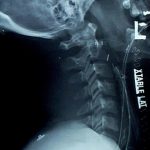This one was a bit tricky. I chose it because it looks like there is an extra tube in the neck. You can see two stripes traveling from the mouth down the neck. The one closest to the cervical spine is in the esophagus, an orogastric tube. The other one passes anterior to it, in the trachea, so it is the orotracheal tube. But what about the tube shaped density that is located in the posterior pharynx that looks like it is angled forward toward the trachea? Did someone lose something?
If you think about it though, you should conclude it’s something weird. There is no radiopaque stripe on it, which rules out most common tubes. The only thing of that size and shape that comes to mind is a nasopharyngeal airway tube. However, these have a flange on the nasal end, so it couldn’t just pass inwards through the nose. And who in their right mind would put it in the mouth to be swallowed? Plus, the orientation of it is unusual, heading forward toward the trachea.
You have to look at the rest of the clues on the radiograph. It’s easy to get suckered if you just focus on the obvious. What are those objects located between the two tube stripes in front of C6? Surgical clips. What are those O-shaped objects at the angle of the mandible that disappear behind the XTABLE LAT marker? Surgical skin closure staples.
So this is a postoperative patient. If you follow the object, it actually moves toward the skin, and beyond! This patient was stabbed in the neck and underwent a surgical exploration with control of bleeding. A surgical drain was placed due to concern for leakage from the pharynx or salivary glands. The drain actually leaves the side of the neck, just anterior to the sternocleidomastoid muscle.
Remember to look at everything on a radiograph, especially if you don’t have the clinical story behind it. The eye normally focuses on the obvious, leading the viewer to make assumptions based on their expectations. This can easily get you in trouble, so beware! And don’t forget that you are looking at a 2-D image, so there is no way to tell where any object is in the third dimension. It may be in the front, the back, or under the patient in their clothing!


